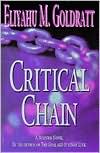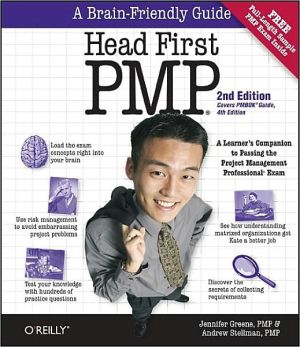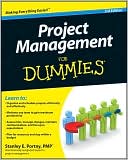Identifying and Managing Project Risk: Essential Tools for Failure-Proofing Your Project
Fully updated and revised to reflect the latest Guide to the Project Management Body of Knowledge (PMBOK® Guide), this essential resource provides clear-cut methods to implement at any organization and for any size or type of project. Identifying and Managing Project Risk takes you step-by-step through every phase of a project, providing real life examples and tips to illustrate key principles in project risk analysis.\ Analyzing aspects such as available resources, project scope, and...
Search in google:
As a project manager, you know that complicated projects are inherently risky business. Between time constraints, technical challenges, and resource difficulties, things that can go wrong often do—which is why one of the most important parts of your job is considering the possible risks involved at every point in the process. Fully updated and consistent with the very latest Guide to the Project Management Body of Knowledge (PMBOK® Guide), Identifying and Managing Project Risk takes you through every phase of a project, helping you guard against failure by improving and increasing your risk analysis capabilities.The book outlines proven methods for project risk planning, drawing on real world situations and hundreds of examples—including what many once considered a truly impossible project, the Panama Canal—to demonstrate key ideas in the risk management process. You’ll learn how to use high level risk assessment tools, implement a complete system for monitoring and controlling projects, and properly document every possible consideration. The book contains sections on the different types of risk to consider when planning; how to identify key issues associated with project metrics; activity sequencing; Work Breakdown Structure (WBS); analysis of scale; and cost estimating and budgeting. Identifying and Managing Project Risk outlines the essential concepts involved in project risk planning and provides indispensable details and advice on topics such as: -The benefits and uses of risk data -Setting limits and defining deliverables -Procurement planning and source selection -Constraint management and risk discovery -Quantitative and qualitative analysis -Project simulation and modeling And much more Analyzing aspects such as available resources, project scope, and scheduling, this new edition also explores the growing area of Enterprise Risk Management as well as other important new developments in the field. This valuable resource moves beyond risk management basics involving insurance, financial, and investment portfolio risk to examine areas like information technology, software engineering, product development, and other high tech fields, giving you a well-rounded understanding of what goes into making project risk identification a crucial element of project management strategy.Your ability to identify and manage project risk is necessary for the smooth and successful completion of all projects, regardless of size, type, or scope. This book will help you eliminate surprises and transform risk into a variable you can manage and keep safely under control. Comprehensive and completely up-to-date, Identifying and Managing Project Risk helps you determine risk factors thoroughly and decisively…before a project gets derailed. Tom Kendrick, PMP, is an internal project management consultant for Visa Inc. and the author of Results Without Authority. He has more than 30 years of project management experience, 12 of which were spent as a part of the Hewlett-Packard Project Management Initiative. He lives in San Carlos, California.
Chapter 1\ Why Project Risk Management?\ Far too many technical projects retrace the shortcomings and\ errors of earlier work. Projects that successfully avoid such pitfalls are often\ viewed as “lucky,” but there is usually more to it than that.\ The Doomed Project\ All projects involve risk. There is always at least some level of uncertainty\ in a project’s outcome, regardless of what the Microsoft Project\ Gantt chart on the wall seems to imply. High-tech projects are particularly\ risky, for a number of reasons. First, technical projects are highly varied.\ These projects have unique aspects and objectives that significantly differ\ from previous work, and the environment for technical projects evolves\ quickly. There can be much more difference from one project to the next\ than in other types of projects. In addition, technical projects are frequently\ “lean,” challenged to work with inadequate funding, staff, and\ equipment. To make matters worse, there is a pervasive expectation that\ however fast the last project may have been, the next one should be even\ quicker. The number and severity of risks on these technical projects\ continues to grow. To avoid a project doomed to failure, you must consistently\ use the best practices available.\ Good project practices come from experience. Experience, unfortunately,\ generally comes from unsuccessful practices and poor project\ management. We tend to learn what not to do, all too often, by doing\ it and then suffering the consequences. Experience can be an invaluable\ resource, even when it is not your own. The foundation of this book is the\ experiences of others—a large collection of mostly plausible ideas that\ did not work out as hoped.\ Projects that succeed generally do so because their leaders do\ two things well. First, leaders recognize that much of the work on any project,\ even a high-tech project, is not new. For this work, the notes, records,\ and lessons learned on earlier projects can be a road map for identifying,\ and in many cases avoiding, many potential problems. Second, they plan\ project work thoroughly, especially the portions that require innovation,\ to understand the challenges ahead and to anticipate many of the risks.\ Effective project risk management relies on both of these ideas.\ By looking backward, past failures may be avoided, and by looking\ forward through project planning, many future problems can be minimized\ or eliminated.\ Risk\ In projects, a risk can be almost any uncertain event associated\ with the work. There are many ways to characterize risk. One of the simplest,\ from the insurance industry, is:\ “Loss” multiplied by “Likelihood”\ Risk is the product of these two factors: the expected consequences\ of the event and the probability that the event might occur. All\ risks have these two related, but distinctly different, components. Employing\ this concept, risk may be characterized in aggregate for a large\ population of events (“macro-risk”), or it may be considered on an eventby-\ event basis (“micro-risk”).\ Both characterizations are useful for risk management, but which\ of these is most applicable differs depending on the situation. In most\ fields, risk is primarily managed in the aggregate, in the “macro” sense. As\ examples, insurance companies sell a large number of policies, commercial\ banks make many loans, gambling casinos and lotteries attract\ crowds of players, and managers of mutual funds hold large portfolios of\ investments. The literature of risk management for these fields (which is\ extensive) tends to focus on large-scale risk management, with secondary\ treatment for managing single-event risks.\ To take a simple example, consider throwing two fair, six-sided\ dice. In advance, the outcome of the event is unknown, but through analysis,\ experimenting, or guessing, you can develop some expectations. The\ only possible outcomes for the sum of the faces of the two dice are the integers\ between two and twelve. One way to establish expectations is to\ figure out the number of possible ways there are to reach each of these\ totals. (For example, the total 4 can occur three ways from two dice: 1 +\ 3, 2 + 2, and 3 + 1.) Arranging this analysis in a histogram results in Figure\ 1-1. Because each of the 36 possible combinations is equally likely, this\ histogram can be used to predict the relative probability for each possible\ total. Using this model, you can predict the average sum over many\ tosses to be seven.\ Figure 1-1. Histogram of sums from two dice.\ If you throw many dice, the empirical data collected (which is another\ method for establishing the probabilities) will generally resemble\ the theoretical histogram, but because the events are random it is extraordinarily\ unlikely that your experiments rolling dice will ever precisely\ match the theory. What will emerge, though, is that the average\ sum generated in large populations (one hundred or more throws) will be\ close to the calculated average of seven, and the shape of the histogram\ will also resemble the predicted theoretical distribution. Risk analysis in\ the macro sense takes notice of the population mean of seven, and casino\ games of chance played with dice are designed by “the house” to exploit\ this fact. On the other hand, risk in the micro sense, noting the range of\ possible outcomes, dominates the analysis for the casino visitors, who\ may play such games only once; the risk associated with a single event—\ their next throw of the dice—is what matters to them.\ For projects, risk management in the large sense is useful to the\ organization, where many projects are undertaken. But from the perspective\ of the leader of a single project, there is only the one project.\ Risk management for the enterprise, or for a portfolio of projects, is\ mostly about risk in the aggregate (a topic explored in Chapter 13). Project\ risk management focuses primarily on risk in the small sense, and\ this is the dominant topic of this book.\ Macro-Risk Management\ In the literature of the insurance and finance industries, risk is described\ and managed using statistical tools: data collection, sampling, and\ data analysis. In these fields, a large population of individual examples is\ collected and aggregated, and statistics for the “loss and likelihood” can be\ calculated. Even though the individual cases in the population may vary\ widely, the average “loss times likelihood” tends to be fairly predictable\ and stable over time. When large numbers of data points from the population\ at various levels of loss have been collected, the population can be\ characterized using distributions and histograms, similar to the plot in Figure\ 1-2. In this case, each “loss” result that falls into a defined range is\ counted, and the number of observations in each range is plotted against\ the ranges to show a histogram of the overall results.\ Figure 1-2. Histogram of population data.\ Various statistics and methods are used to study such populations,\ but the population mean is the main measure for risk in such a population.\ The mean represents the typical loss—the total of all the losses\ divided by the number of data points. The uncertainty, or the amount of\ spread for the data on each side of the mean, also matters, but the mean\ sufficiently characterizes the population for most decisions.\ In fields such as these, risk is mostly managed in the macro sense,\ using a large population to forecast the mean. This information may be\ used to set interest rates for loans, premiums for insurance policies, and\ expectations for stock portfolios. Because there are many loans, investments,\ and insurance policies, the overall expectations depend on the average\ result. It does not matter so much how large or small the extremes\ are; as long as the average results remain consistent with the business objectives,\ risk is managed by allowing the high and low values to balance\ each other, providing a stable and predictable overall result.\ Project risk management in this macro sense is common at the\ project portfolio and enterprise levels. If all the projects undertaken are\ considered together, performance primarily depends on the results of\ the “average” project. Some projects will fail and others may achieve\ spectacular results, but the aggregate performance is what matters to\ the business bottom line.
AcknowledgmentsIntroductionCh. 1Why Project Risk Management?1Ch. 2Planning for Risk Management17Ch. 3Identifying Project Scope Risk37Ch. 4Identifying Project Schedule Risk68Ch. 5Identifying Project Resource Risk104Ch. 6Managing Project Constraints and Documenting Risks132Ch. 7Quantifying and Analyzing Activity Risks158Ch. 8Managing Activity Risks182Ch. 9Quantifying and Analyzing Project Risk221Ch. 10Managing Project Risk264Ch. 11Monitoring and Controlling Risky Projects290Ch. 12Closing Projects320Ch. 13Conclusion331App.: Selected Detail from the PERIL Database337Selected Bibliography345Index349
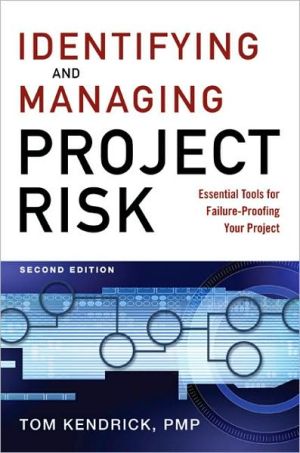
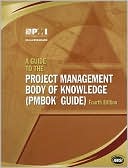


![Microsoft Office Project 2007 Step by Step [With CDROM] Microsoft Office Project 2007 Step by Step [With CDROM]](/application/data/covers/30/57/9780735623057.jpg)
